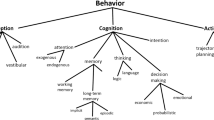Abstract
A previously described neural-network model (Desmond 1991; Desmond and Moore 1988; Moore et al. 1989) predicts that both CS-onset-evoked and CS-offset-evoked stimulus trace processes acquire associative strength during classical conditioning, and that CR waveforms can be altered by manipulating the time at which the processes are activated. In a trace conditioning paradigm, where CS offset precedes US onset, the model predicts that onset and offset traces act in synchrony to generate unimodal CR waveforms. However, if the CS duration is subsequently lengthened on CS-alone probe trials, the model predicts that onset and offset traces will asynchronously contribute to CR output and bimodal CRs will be generated. In a delay conditioning paradigm, in which US onset occurs prior to CS offset, the model predicts that only the onset process will gain associative strength, and hence, only unimodal CRs will occur. Using the rabbit conditioned nictitating membrane response preparation, we found experimental support for these predictions.
Similar content being viewed by others
References
Anderson NH (1959) Temporal properties of response evocation. In: Bush RR, Estes WK (eds) Studies in mathematical learning theory. Stanford University Press, Stanford, California, pp 125–134
Bartha GT, Thompson RF, Gluck MA (1991) Sensorimotor learning and the cerebellum. In: Arbib M, Ewert J (eds) Visual structures and integrated functions. Springer, Berlin Heidelberg New York
Berthier NE, Moore JW (1990) Orbicularis oculi and extraocular muscle activity during unconditioned and conditioned eyeblinks in the rabbit. Soc Neurosci (abstr) 16:916
Coleman SR, Gormezano I (1971) Classical conditioning of the rabbit's (Oryctolagus cuniculus) nictitating membrane response under symmetrical CS-US interval shifts. J Comp Physiol Psychol 77:447–455
Desmond JE (1991) Temporally adaptive responses in neural models: The stimulus trace. In: Gabriel M, Moore JW (eds) Learning and computational neuroscience: foundations of adaptive networks. MIT Press, Cambridge, pp 421–456
Desmond JE, Moore JW (1988) Adaptive timing in neural networks: the conditioned response. Biol Cybern 58:405–415
Dickinson A, Mackintosh NJ (1978) Classical conditioning in animals. Ann Rev Psychol 29:587–612
Gormezano I (1966) Classical conditioning. In: Sidowski JB (ed) Experimental methods and instrumentation in psychology. McGraw-Hill, New York
Gormezano I (1972) Investigations of defense and reward conditioning in the rabbit. In: Black AH, Prokasy WF (eds) Classical conditioning II: current research and theory. Appleton-Century-Crofts, New York, pp 151–181
Gormezano I, Gibbs CM (1988) Transduction of the rabbit's nictitating membrane response. Behav Res Methods Instrum Comput 20:18–21
Gormezano I, Kehoe EJ (1981) Classical conditioning and the law of contiguity. In: Harzern P, Zeiler MD (eds) Predictability, correlation, and contiguity. Wiley, New York, pp 1–45
Gormezano I, Kehoe EJ, Marshall BS (1983) Twenty years of classical conditioning with the rabbit. Prog Psychobiol Physiol Psychol 10:197–275
Grossberg S, Schmajuk NA (1989) Neural dynamics of adaptive timing and temporal discrimination during associative learning. Neural Networks 2:79–102
Guthrie EH (1933) Association as a function of time interval. Psychol Rev 40:355–367
Hoehler FK, Leonard DW (1976) Double responding in classical nictitating membrane conditioning with single-CS dual-ISI training. Pav J Biol Sci 11:180–190
Hull CL (1943) Principles of behavior. Appleton-Century-Crofts, New York
Kamin LJ (1965) Temporal and intensity characteristics of the conditioned stimulus. In: Prokasy WF (ed) Classical conditioning. Appleton-Century-Crofts, New York, pp 118–147
Kamin LJ (1968) Attention-like procseses in classical conditioning. In: Prokasy WF (ed) Classical conditioning: a symposium. Appleton, New York, pp 118–147
Keppel G (1973) Design and analysis: a researcher's handbook. Prentice-Hall, Englewood Cliffs, NJ
Kimmel HD (1965) Instrumental inhibitory factors in classical conditioning. In: Prokasy WF (ed) Classical conditioning. Appleton-Century-Crofts, New York, pp 148–171
Klopf AH (1986) A drive reinforcement model of single neuron function: An alternative to the Hebbian neural model. In: Denker JS (ed) Neural networks for computing. AIP Conference Proceedings 151. American Institute of Physics, New York
Klopf AH (1968) A neuronal model of classical conditioning. Psychobiology 16:85–125
Millenson JR, Kehoe EJ, Gormezano I (1977) Classical conditioning of the rabbit's nictitating membrane response under fixed and mixed CS-US intervals. Learn Motiv 8:351–366
Moore JW, Desmond JE, Berthier NE (1989) Adaptively timed conditioned responses and the cerebellum: a neural network approach. Biol Cybern 62:17–28
Patterson MM (1970) Classical conditioning of the rabbit's (Oryctolagus cuniculus) nictitating membrane response with fluctuating ISI and intracranial CS. J Comp Physiol Psychol 72:193–202
Pavlov IP (1927) Conditioned Reflexes (Translated by G.V. Anrep). Dover, New York
Scandrett J, Gormezano I (1980) Microprocessor control and A/D acquisition in classical conditioning. Behav Res Meth Inst 12:120–125
Smith MC (1968) CS-US interval and US intensity in classical conditioning of the rabbit's nictitating membrane response. J Comp Physiol Psychol 66:679–687
Sutton RS, Barto AG (1981) Toward a modern theory of adaptive networks: expectation and prediction. Psychol Rev 88:135–170
Author information
Authors and Affiliations
Additional information
This research was supported by National Science Foundation grant BNS 88-10624 and Air Force Office of Scientific Research grant 89-0391.
Rights and permissions
About this article
Cite this article
Desmond, J.E., Moore, J.W. Altering the synchrony of stimulus trace processes: tests of a neural-network model. Biol. Cybern. 65, 161–169 (1991). https://doi.org/10.1007/BF00198087
Received:
Accepted:
Issue Date:
DOI: https://doi.org/10.1007/BF00198087




